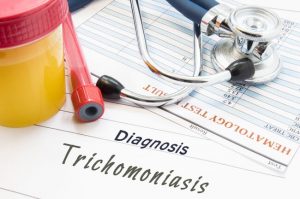Trichomoniasis, also referred to as “trich,” is an STD caused by an anaerobic, flagellated protozoan parasite called Trichomonas vaginalis. It represents one of the most prevalent pathogenic protozoan infections in industrialized countries. The number of infected individuals in the US is almost 4 million per year.
The biggest problem with trichomoniasis is the fact that infected individuals usually do not show any symptoms or experience them intermittently. If the infection is left untreated, it can easily be mistaken for a urinary tract infection.
The parasite is most commonly transmitted during unprotected sexual intercourse, but it can also pass from vagina to vagina or through contact with vaginal lubrication, semen, menstrual blood, and discharge. Trich can also be transmitted if individuals share sex toys or during mutual masturbation. The parasite usually infects the vaginal and urinary tract, which affects the cervix, urethra, and vulva in women and the urethra and areas under the foreskin in men. The infection can pass from mother to child during childbirth, but this happens very rarely.

Testing Solutions For Trichomoniasis
A trich infection is impossible to diagnose just by observing the symptoms and it can last for months or even years if left untreated. Diagnosing the infection is usually done by analyzing a discharge sample, which requires a urine sample or urethral swab for men and a pelvic exam for women. The least invasive method of testing for trichomoniasis in both men and women is using a urine sample. “Wet preparation” or “wet mount” is the most widespread testing solution for women, entailing discharge evaluation under a microscope to establish the presence of the parasite. If microscopy cannot confirm the presence of the pathogen after the infection was discovered during a Pap smear exam, a Trichomonas vaginalis culture can be performed as well.

The best results are achieved if the patient manages to collect the first 20-30 ml of the initial urine stream (also called the “first catch” or the “first void”). The patient should also abstain from urinating for at least an hour before sample collection.
Potentially infected individuals can also opt for nucleic acid probe or rapid antigen blood tests if they want quicker results (usually within minutes). The problem is, these tests offer far less reliable results compared to the ones performed using discharge samples.
Note that most STD panels don’t include trichomoniasis, so you’ll probably have to request the test specifically.
